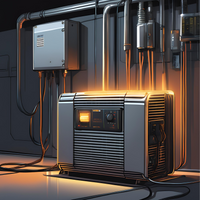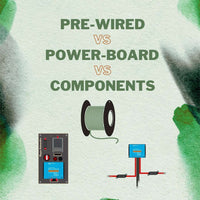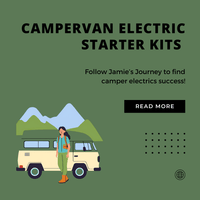🛠️ Portable Power Stations vs Traditional Leisure Battery Setups: Which Is Best for Your Camper Conversion?
If you're in the middle of a camper conversion or planning a self-build, chances are you’ve come across portable power stations like Jackery, Bluetti, or Ecoflow. These compact, all-in-one battery packs promise easy, off-grid power without complex wiring or installation.
But how do they really stack up against a traditional leisure battery setup with a dedicated DC to DC charger and fuseboard?
This post compares both systems — their pros, cons, and use cases — so you can make the right decision for your camper project.
🔌 What Is a Portable Power Station?
Portable power stations are self-contained lithium battery and inverter units with:
-
Built-in 230V inverter
-
12V cigarette socket (often only one)
-
USB ports
-
Limited input options (solar, mains, or sometimes 12V car input)
They're marketed as a “plug and play” power solution for camping, van life, and emergencies.
🔋 What Is a Traditional Leisure Battery Setup?
A traditional camper electrical system usually includes:
-
A leisure battery (AGM, or Lithium)
-
A DC to DC charger for charging from the alternator
-
Fused 12V circuits for lights, fridge, fans, etc.
-
Optional inverter for mains appliances
-
Solar input (via a charge controller)
-
Permanent wiring looms integrated into the build
⚖️ Side-by-Side Comparison
| Feature | Portable Power Station | Traditional Leisure Battery Setup |
|---|---|---|
| Installation | Quick, minimal tools | Needs fitting and planning |
| DC Output Options | Often just one 12V socket (10A max) | Can be fully set up to meet all current needs |
| AC Protection | Limited (no RCD/MCB) just inbuild untestable protection (or you need to add external) | Fully testable in accordance with regulations, 18th Edition RCDs/MCBs |
| Repairability | Sealed units | Modular and serviceable |
| Mounting | Not designed for permanent fitting (except Clayton) | Secure, integrated install |
| Battery Choice | Fixed by manufacturer | Full flexibility and choice of capacities (AGM, lithium, size) |
| Price | £400–£3,000+ | £300–£3000+ depending on kit |
| Expandable? | Very limited to extra battery packs | Yes — add larger batteries, multiple solar arrays |
| Use Case | Camping | Long-term touring, full conversions |
✅ Where Power Stations Excel
Let’s be fair — these units do have some real advantages:
-
Fast deployment: You can be up and running in minutes if you're in a tent or camping.
-
Compact & portable: Great for use outside the van or as a backup
-
No hardwiring required (at first glance)
They’re ideal for:
-
non permanent campers
-
Festivals
-
Tent-based overlanders
-
Emergency home backup
🚧 Limitations of Power Stations for Camper Conversions
That said, for full-time use or serious touring, these units do come with some significant limitations:
1. Restricted 12V Outputs
Most units only provide one 12V cigarette socket, which makes them:
-
Impossible to wire into your van’s lights, water pump, or fridge easily or safely, 10A is already pushing it for a 12V socket, Most fridges and diesel heaters require at least 15A fuses. so they're not compatible.
-
Dependent on adapters and splitters (messy and unreliable)
For a proper install, you still need a custom wiring loom, fusebox, and routing — so you haven’t escaped installation after all.
2. No Safety-Tested AC Protection
While they include a 230V inverter, they often lack safety protections like:
-
RCDs (residual current devices)
-
MCBs (miniature circuit breakers)
-
External isolation switches
- Chassis bonding
In a campervan, that’s a real safety concern. Proper camper electrics should follow UK safety guidelines, like those outlined by the NCC and BS 7671 (IET Wiring Regs). (Full guide coming soon here)...
3. Sealed and Non-Repairable
Most power packs are sealed. That means:
-
You can't upgrade or replace internal batteries
-
You can’t service internal fuses or switches
-
When it fails, it’s likely landfill
Your traditional system, however, can be fixed, replaced, or expanded — for years to come.
4. Difficult to Mount Securely
These units aren’t designed to be bolted in — and a heavy battery sliding around on a Welsh B-road isn’t ideal.
With a fixed system, your leisure battery, fusebox, and DCDC charger are all mounted safely and wired out of sight. Especially if you're mounting them onto our power boards.
5. Battery Chemistry and Size Are Fixed
You don’t get a say in:
-
Battery size (unless you pay for a bigger model) Even the biggest are often only equivalent to about 230Ah at 12V, which is in 2025 considered the smaller end of a Lithium battery system, some going up to about 628Ah or above.
-
Chemistry (Li-ion, LiFePO4, etc.)
-
Number of cycles or discharge rate.
In a traditional system, you can spec your battery to suit your needs — whether that’s a 75Ah AGM or a 600Ah LiFePO4.
🧰 What About the Clayton LPS?
The Clayton LPS is a bit of a hybrid system. It includes:
-
Better 12V and AC connectivity
-
Proper DCDC input for alternator charging
-
Sleek design with integrated solar and inverter
But it’s still limited:
-
Smaller models have less battery capacity than a full leisure setup
-
Price is high for the capacity you get
-
Still not truly modular or user-serviceable
It’s a better option than most all-in-ones — but still not as scalable or versatile as having a DC system built.
🏁 Conclusion: Use the Right Tool for the Job
If you’re doing a day van or something which doesn't require any DC power, just charging a few phones from USBs and a few rechargeable lights, then a power pack might be an option.
But if you're wiring in diesel heaters (think Truma Kombi or Autoterm), fridge, pumps, or lots of solar — or want your van to handle long-term off-grid travel — there’s no substitute for a proper leisure battery setup.
It’s more:
-
Customisable
-
Serviceable
-
Safe
-
Tailored to your build
And with kits like ours, setting up your camper electrics is simpler than ever — including the DC to DC charger, correct cables, and fuses, all pre-selected for you.
🔗 Need Help With Your Camper Electrics?
Check out our complete campervan electrical kits — designed to take the guesswork out of building your own system. Whether you're installing a fridge, lights, or just want solid off-grid power, we can help you get it right.







